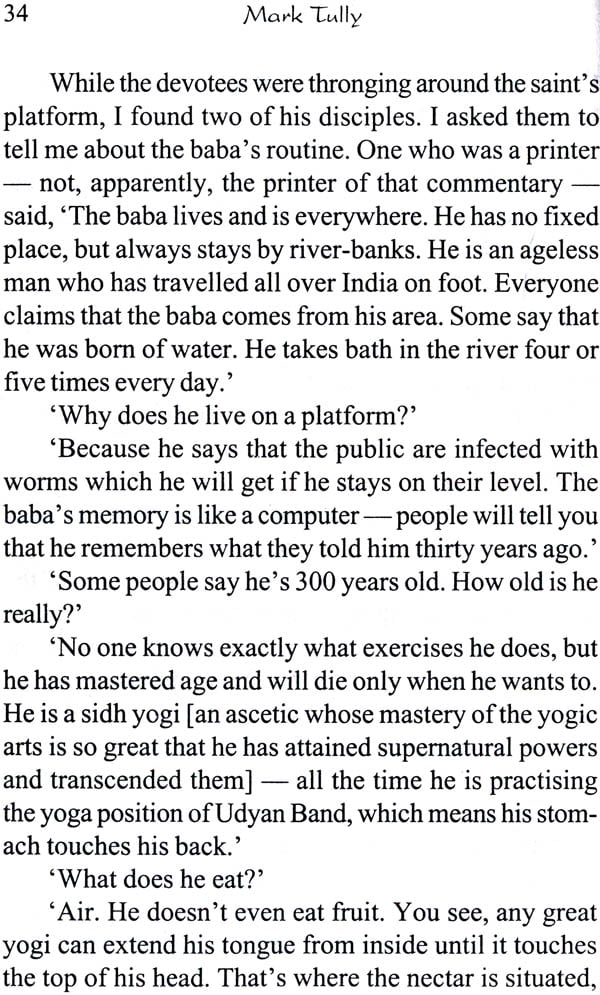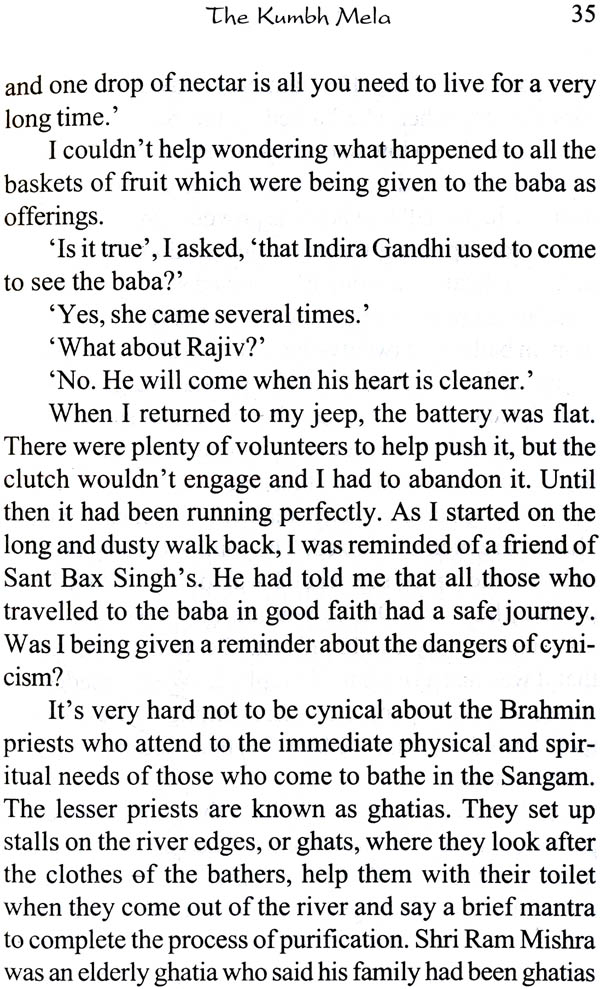
The Kumbh Mela
Book Specification
| Item Code: | IDD707 |
| Author: | Mark Tully |
| Publisher: | Indica Books, Varanasi |
| Language: | English |
| Edition: | 2001 |
| ISBN: | 8186569227 |
| Pages: | 80 (B & W Illus: 16) |
| Cover: | Paperback |
| Other Details | 7.2" X 4.7" |
| Weight | 90 gm |
Book Description
Where the Ganges the Jamna meet people from many, many, different traditions of Hinduism come together. There will be many genuinely holy men, some charlatans, and some obscurantists. But the majority of those who come to bathe in the Sangam will be villagers. The Kumbh is an awe -inspiring demonstration of simple piety and a clear example of the power of myth.
Of course the Kumbh Mela is a magnificent spectacle too. Millions of people gathered in one place, colorful holy men, naked sadhus, wondrous feats of asceticism, piety on a scale unparalleled anywhere else. But much more than a spectacle, the Kumbh Mela is an experience, an experience for which we have to shed our certainties and our self-confidence to be able to capture its meaning through the power of the imagination.
Mark Tully was born in Calcutta and educated in England. He spent over twenty years of his life as BBC Delhi Correspondent and covered many of the major events in South Asia, including the 1971 Bangladesh war, the Indian Emergency the trial and hanging of Zulfiqar Ali Bhutto, Operation Blue Star, the assassinations of Indira and Rajive Gandhi, the Destruction of the Ayodhya Mosque, and the Bhopal gas disaster. After leaving the BBC he continued to live in Delhi with his partner Gillian Wright and work as a freelance broadcaster, journalist, and writer. He has now written four books on India
This description of the last Maha Kumbh Mela of the twentieth century was first published as part of a book called No Full Stops in India. In the introduction I, perhaps rather pompously, described the stories as parables. The intention of the parables was to "illustrate the way Western thinking has distorted and still does distort Indian life". Over the last twelve years I have come to think differently. I now believe it is contrary to the genius ofIndia's ancient wisdom to pit West against East, or the other way round. I would agree with Swami Ved Bharati, a distinguished Sanskrit scholar and theo- logian. When I was working on a radio series about the contribution Eastern thought could make to the West he said to me, "I think there is a continuum of cultures, just a continuum, as there is always in the universe. You can't say East believes this, West believes that, Christianity believes this versus Hinduism believes that". There is a continuum which lies under the mythology and the mys- ticism of the East and the West, and the Kumbh Mela symbolises that continuum because it is a flowing to- gether of different cultural traditions.
Where the Ganges and Jamna meet people from many, many, different traditions of Hinduism come to- gether. It is a religion so diverse that scholars often deny it can be classified as one faith, and yet in Hinduism you don't find the hostility between different schools of the- ology, different sects, which has been such a feature of religions of the Semitic traditions. This is because the Indian tradition has always been profoundly suspicious of certainty, has accepted that God is indefinable, and that many roads lead to salvation, so no one can claim a monopoly of the truth. The Oxford scholar, R.C. Zaehner, wrote "Hindus do not think of religious truth in dogmatic terms: dogma can not be eternal but only the transitory, distorting images of a truth that transcends not only them but all verbal definition. For the passion for dogmatic certainty that has racked the religions of Semitic origin from Judaism itself, through Christianity and Islam, to the Marxism of our day, they feel nothing but shocked incomprehension." To that list ofreligions of certainty should be added today's dominant faith- market capitalism.
The Kumbh Mela also brings together people of very different backgrounds. There will be well educated and prosperous pilgrims, and those who have come to ply their trade - barbers and boatmen will be in big demand. Politicians will come to do their business too. There will be many genuinely holy men, some charla- tans, and some obscurantists. But the majority of those who come to bathe in the Sangam will be villagers. Many will have travelled long distances in overcrowded railway trains, they will have nothing but the barest ne- cessities with them and may have nowhere to sleep except the banks of the rivers. Their faith is based on custom and tradition, and at the last Kumbh they were dismissed by many journalists and commentators as su- perstitious. But one person's superstition is another person's faith.
Throughout the ages it has been the simple piety of faithful people who have not had the chance to be edu- cated, or the leisure to reflect deeply, which has been the bedrock of all religions. The theologians with their logic chopping, their attempts to define the indefinable have all too often caused chaos and confusion. The Kumbh is an awe-inspiring demonstration of simple pi- ety. For the educated to acknowledge that piety is to accept and appreciate what should be obvious - that everyone's religion, or rejection of religion, is deeply influenced by. their birth, education, and the circum- stances of their life. It's a humbling experience to accept that there is no absolute free will, no totally independent intellect, but respecting the piety of all at the Kumbh Mela teaches that humility. The Dalai, when asked re- cently in Delhi why there were different schools of Ti- betan Buddhism, replied, "because there are different sorts of people". In his simple direct way the Dalai Lama was also teaching that humility.
The Kumbh Mela is also an inspiring example of the power of myth. Scholars have picked away at the story of Jesus and other historical religious leaders leaving only the driest of bones for us to gnew on. if we want the a richer diet we have to go to the myths lying behind the great religious traditions, and of course that does not mean putting our faith in lies as so many critics of reli- gion would have us believe. For me, a Christian, it has been very difficult to make that leap from history to myth, and I am still sure that I don't abandon my rational train- ing sufficiently and let my imagination have free rein. That's much easier for the Hindus who will gather in Allahabad because theirs is a religion beyond the reality of history, a religion of the imagination which goes be- yond reason. It does not matter to them whether the gods and demons did chum up the ocean or not, it's the meaning behind the myth which matters.
The Kumbh story is a creation myth, which inspires reverence for the sanctity of all creation. It's a rever- ence we need to regain if we are to make a radical change in our attitude to nature instead of arguing over indi- vidual environmental problems, and trying to solve them piecemeal with carbon sinks, carbon quotas, and all the other devices of politicians who are not prepared to ad- vocate the major mind-change we need to make. Sadly they include Indians who are no more prepared to ac- cept the wisdom of the Kumbh Myth than politicians anywhere else are.
Of course the Kumbh Mela is a magnificent specta- cle too. Millions of people gathered in one place, colorful holy men, naked sadhus, wondrous feats of asceticism, piety on a scale unparalleled anywhere else, and at the last Kumbh Mela amazing peace and order on the great bathing days. But for me the last Kumbh Mela was much more than a spectacle, or a story I reported as an out- sider, it was an experience. That was as it should have been, for in the East the emphasis has always been on experience whereas in the West all too often it has been on teaching and dogma - learning from others not our self, from outside not inside. A Roman Catholic cardi- nal recently admitted there was validity in the criticism of his Church's "lack of lived experience, the fear of mysticism, the endless moral exhortations, and the ex- aggerated insistence on the orthodoxy of doctrine." But to experience the Kumbh Mela we have to shed our cer- tainties and our self-confidence, and we have to experi- ence its meaning through the power of the imagination. The modem English poet Kathleen Raine said her life's work had been, in the learning of the imagination. She has described India as "the supreme civilization of the imagination" .
| Title | Page no |
| Introduction | 5 |
| The Kumbh Mela | 11 |
| Photographs | 73 |







